Fast Bug-Out Bag, AKA “Fast BOB”
Designed to help keep you alive for up to 72 hours, this BOB has what you need to escape fast-moving danger.
https://www.youtube.com/watch?v=neBFf9ca5Lw
I have two bug-out bags, the Fast BOB and the Big BOB. The Fast BOB is designed to keep me alive for at least 72 hours. It forms the core of the Big BOB, which is designed to keep me alive for over a week, and possibly indefinitely. This article covers the contents of the Fast BOB. I will cover the Big BOB in the next article.
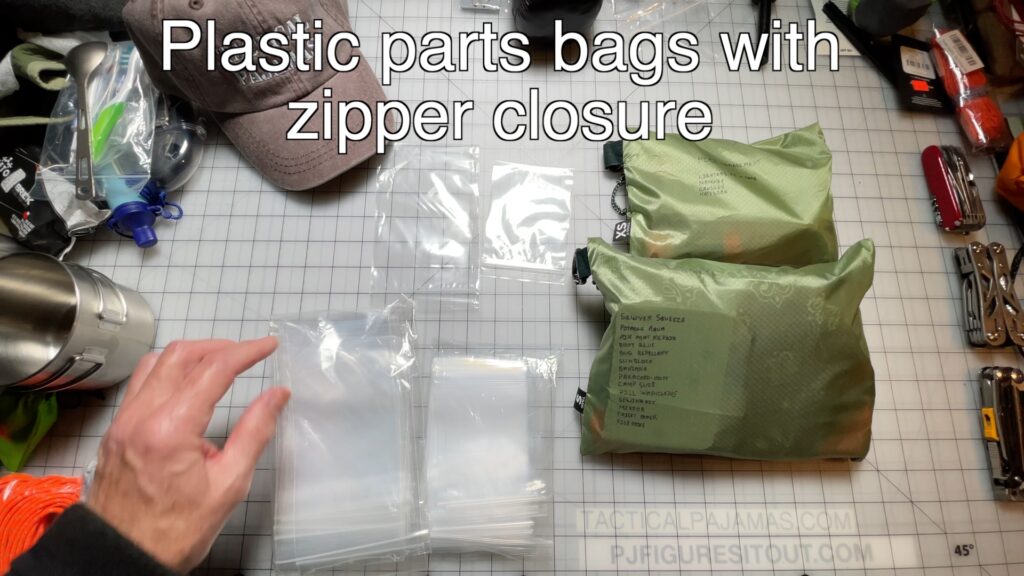
Before I get to the contents, some tips on organization. First, I like these little zip-close plastic parts bags. They’re smaller and stiffer than sandwich bags, and the perfect size for many items or sets.
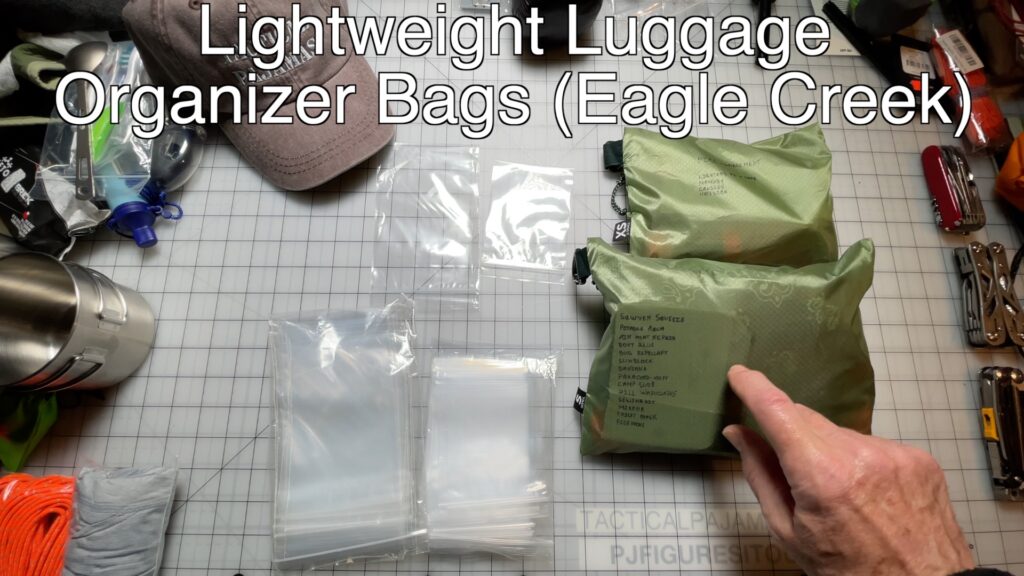
One level up from the parts bags is these luggage organizing bags from Eagle Creek. They are lightweight and tough, and I write the contents on each one so I can make sure everything that’s supposed to be in them is in them.
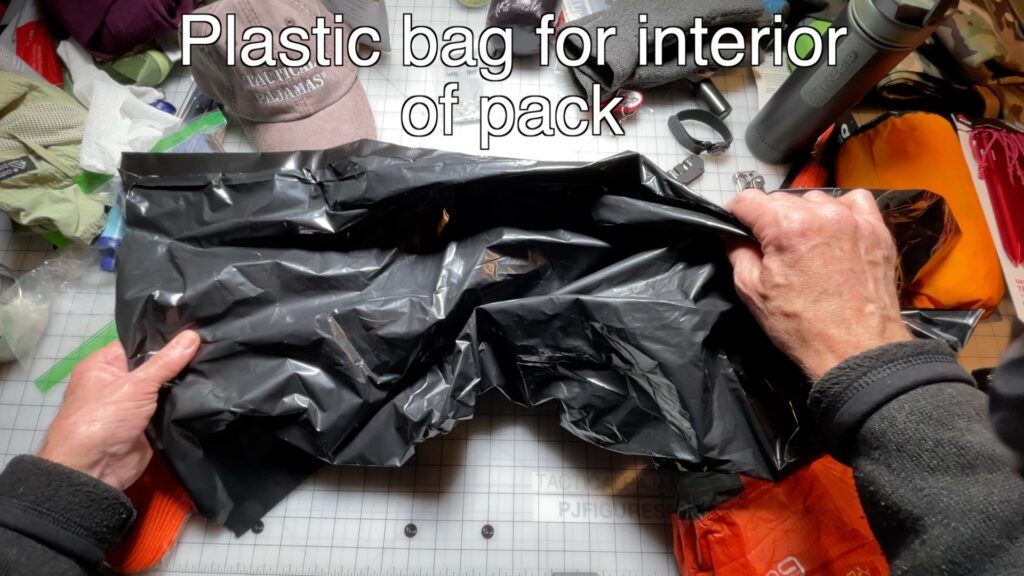
Also, don’t rely on outside covers to keep the contents of the backpack dry. Take a thick plastic contractor trash bag, and cut it to a size that can fold down over the contents without leaving too much excess. This will also enable you to quickly transfer everything from the Fast BOB to the Big BOB if required. The Big BOB should have a similar plastic bag of its own.
Here is what’s in the Fast BOB:
*Money— Some people advocate having $1000 in your BOB. I don’t have a thousand dollars just laying around, do you? Since the price of gas has gone up so much, I’d recommend about $350, if you can spare it.
*Credit card(s)— I recommend that you pack at least one. See this article for more information.
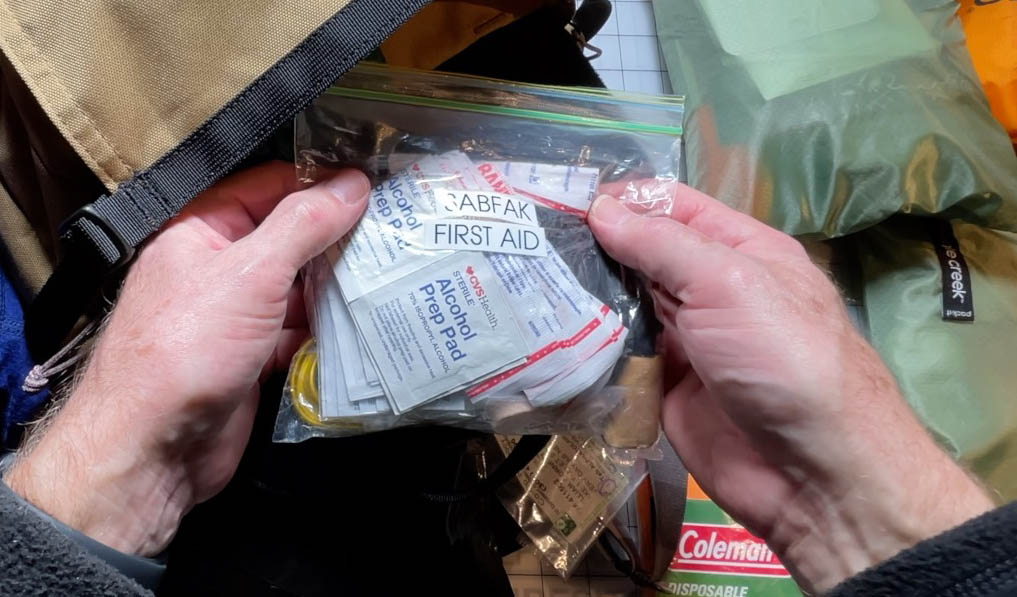
*SABFAK first aid kit— With this 6-ounce kit you can treat anything from gunshot wounds to amputations to wild animal attacks to food poisoning. See more at this link.
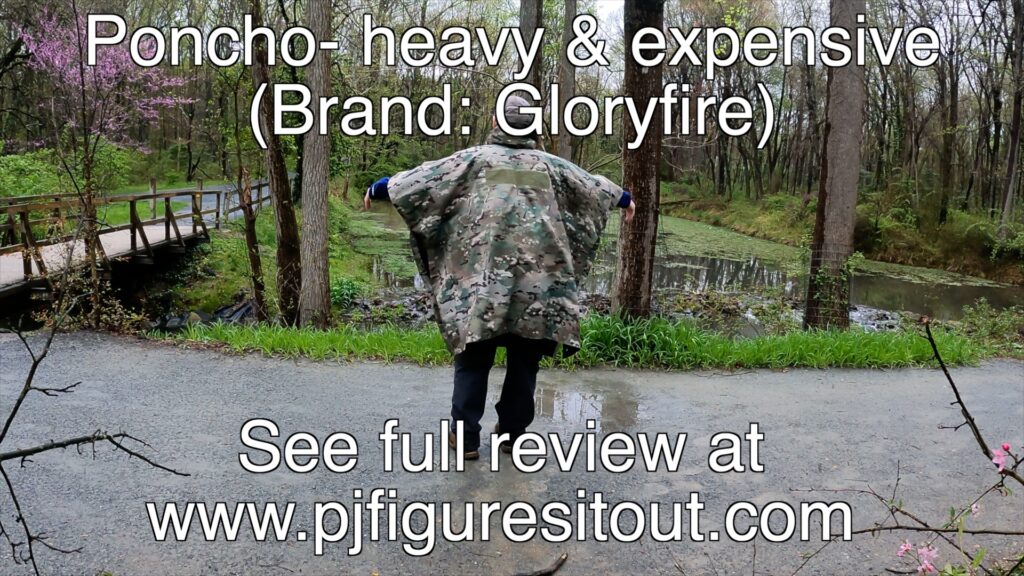
*Poncho— There are plastic ones which are cheap and light; expensive ones which are tough, breathable, versatile, and heavy; and a few in-between. The Coleman is lightweight plastic and costs a couple of bucks. The Gloryfire Breathable Poncho weighs two pounds and costs about $90.
*Sewing kit (small)— If a strap comes off your pack or your clothing rips a seam, a simple needle and thread can be a lifesaver.
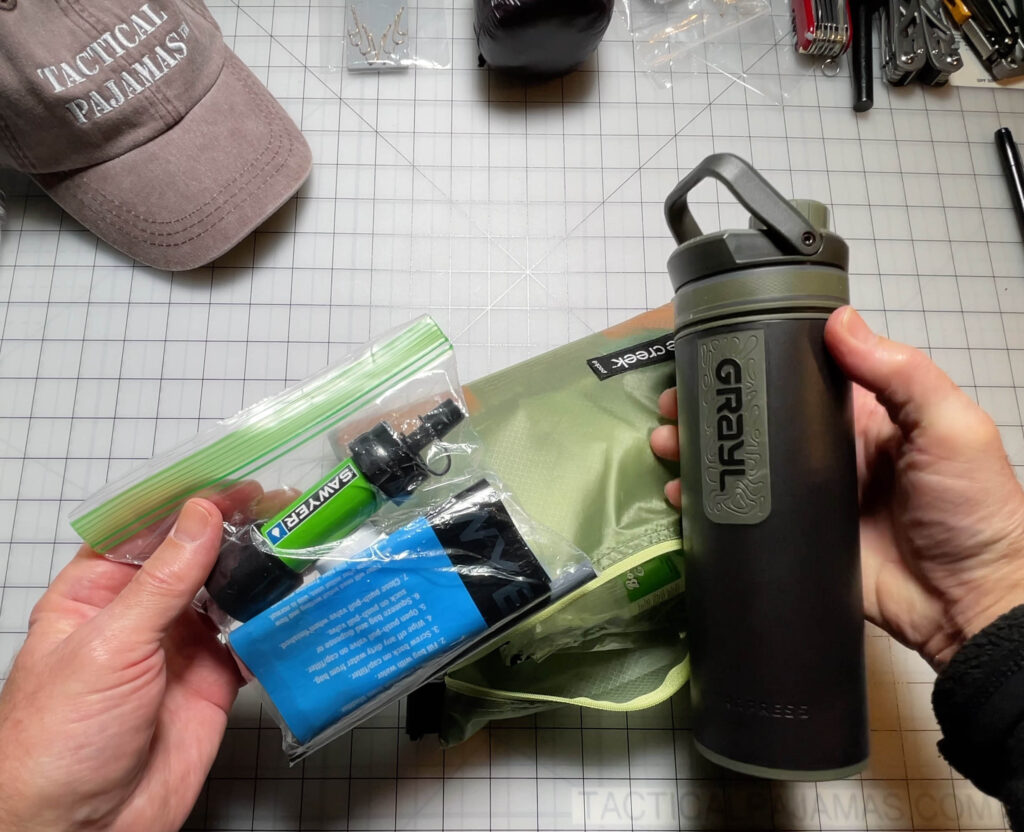
*Water filter— You need to have a good, lightweight water purification system. The Grayl is top-notch, but it costs nearly $100. The Sawyer Squeeze is slow and cumbersome but will do fine in a pinch, and it costs a lot less. Get what suits your budget.
*Water purification tablets— As a back-up to the water filter. Put them in a quart of water and four hours later it’s safe to drink, at least in terms of microbial contamination.
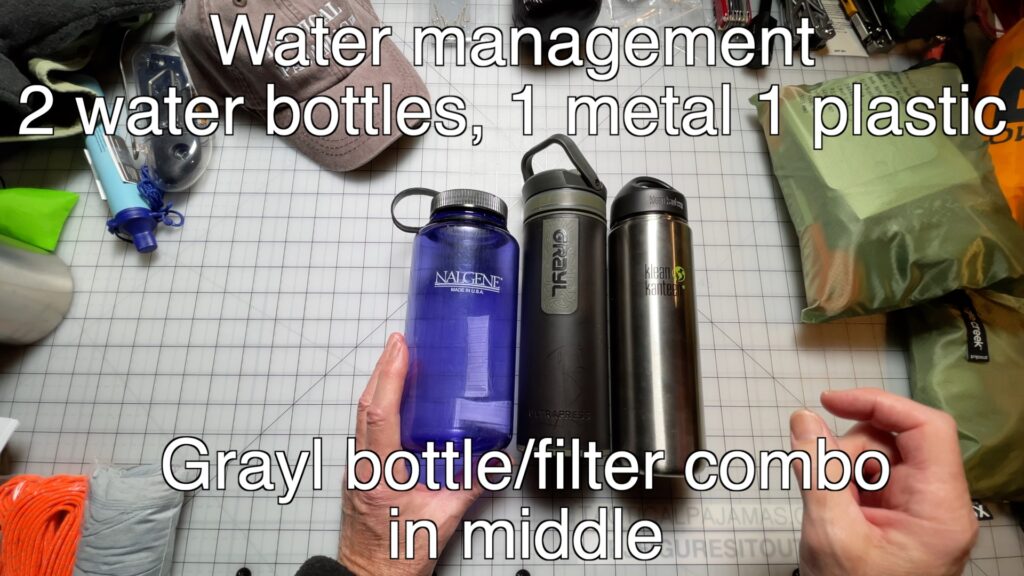
*Water bottle— If you aren’t using the Grayl, get one metal and one plastic bottle, both with large mouths for scooping up water from streams and such. You can use the metal one to boil water in as a second back-up if you’re out long enough to use up all your water purification tablets. The Grayl is its own bottle, so if you use it you’ll just need one other bottle, preferably metal.
*Pre-filled water bottles— If you’re bugging out because of a natural disaster, for the first several miles you probably won’t have time to stop and filter water, assuming you can find it at all. Put a couple of them in a plastic grocery bag and tie it to a strap on the BOB.
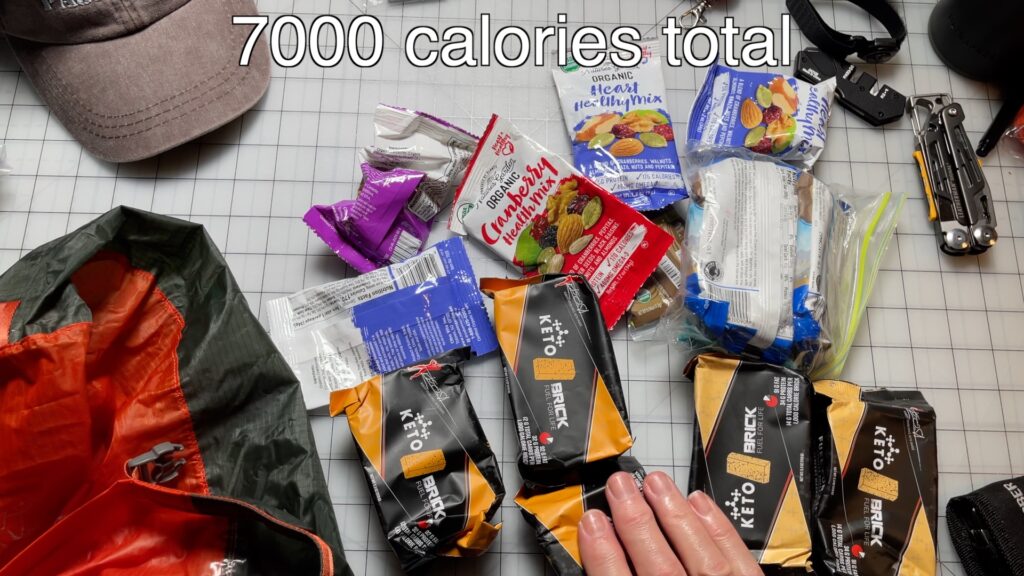
*Food bars/freeze-dried meals for two days rations— You can survive for up to three weeks without food if you’re sedentary, but if you have to hike you need fuel. 2000 calories a day is the minimum, and you can burn up 5,000 calories a day (or more!) on a forced hike. One of the most calorie-dense, shelf-stable foods is Keto Brick. You can use it as the base for a total diet if you are on keto or as a fat-heavy supplement if you’re not. Each 1000-calorie bar weighs less than six ounces, and 3000 calories is a bit over a pound. I also carry Cliff Bars and 250-calorie packs of trail mix from Costco.
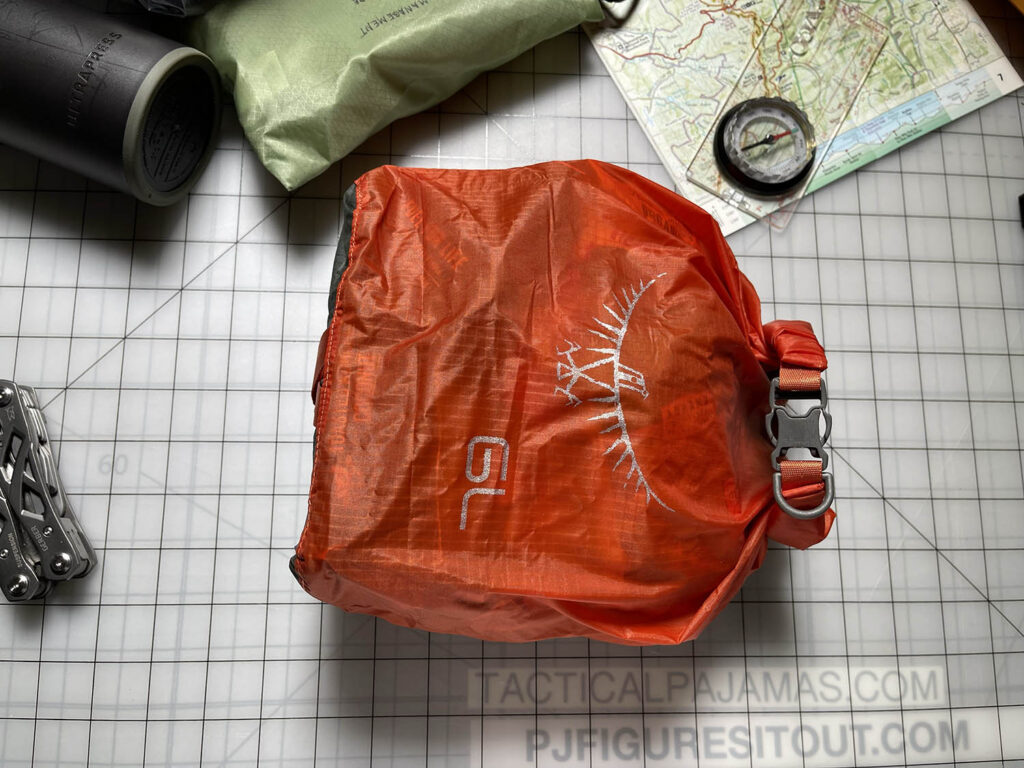
*Dry Bag– I keep my food in a lightweight dry bag. This one holds six liters and weighs three ounces. The opening locks down to hermetically seal the contents, which reduces food smell and thus the attraction to critters. Since it’s waterproof I can carry it on the outside of the pack to save space inside, if required.
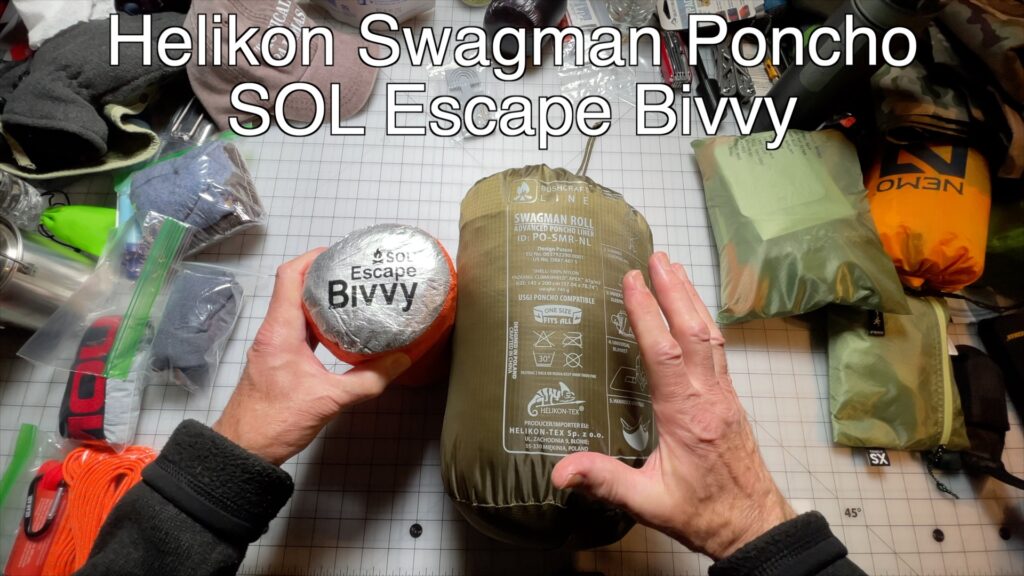
*Sleep System– I use a combination of the Helikon Swagman and the SOL Escape Bivvy.
*SOL Escape Bivvy— This is a great primary element for a survival sleeping system. If you are wearing sufficient clothing and the weather is not super-cold, it may be all you need. However, people vary greatly in their response to exposure, so test it out first. I find that for my metabolism, when wearing winter clothing it’s good down to about 55 degrees F. It only weighs 8 ounces and packs down to about 4″ x 8″.
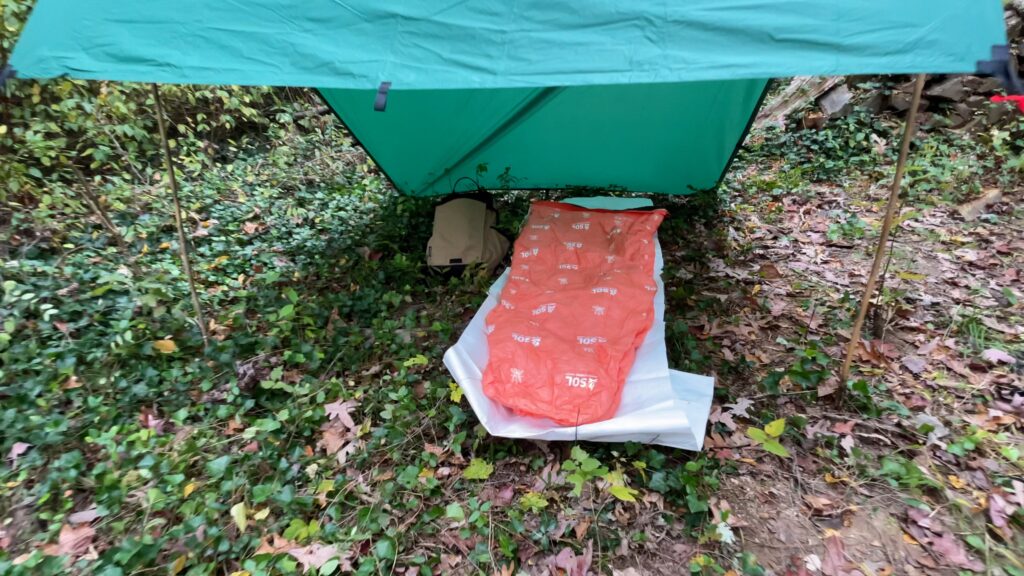
Helikon Swagman Poncho Liner– This is an incredibly versatile garment. It is waterproof and insulated, with straps that clip it tight to the body for outstanding heat retention. As well, there’s a zipper around two sides that turns it into an excellent sleeping bag. When combined with the SOL Escape Bivvy, it’s comfort rating is about 43 degrees and it’s survival rating is around freezing. Full review coming soon.
*Lighters— For the Fast BOB, I recommend two cheap lighters. Save the big spark sticks for the Big BOB, as the lighters should be more than sufficient to hold you through 72 hours. Wrap at least one lighter with five feet of Gorilla Tape.
*Candles/tinder (for use in starting fires)— If the weather is wet you’ll need help getting a fire started. Tea candles like this are cheap, lightweight, and very effective.
*Flashlight (must be dimmable so it can last many hours if necessary)— I prefer a dimmable headlamp that takes AAA batteries, with the batteries stored outside the device. Re-chargeable flashlights are wonderful, but the batteries can lose charge very quickly in storage. See this article on choosing a flashlight.
*Sunblock/lip balm— A zinc-based sunblock will have a longer shelf life than most other types. These are small, pack two or three.
*Bug repellant— I recommend non-Deet repellants, mainly because Deet will cause the materials in most tents and sleeping bags to disintegrate. This type right here, called “No Bite Me,” goes a long way, this one tiny jar will last 5-10 applications, and it’s very effective.
*Hat— Get a lightweight type with a full brim or back-flap to keep the sun off the back of your neck, or a baseball-type cap and use your bandanna as a neck cape.
Beanie— You’ll want something more insulating than the brimmed hat for when it gets cold. I have this alpaca-wool beanie, but any good one will do. It also forms part of my sleep system.
*Bandana (maybe several)— From filtering water to sun protection to wrapping injuries, bandanas have tons of uses.
*Gorilla Tape, about 5-10 feet— for repairs from minor to major. You can even use it to tape up gaping wounds in dire emergencies. Wrap it around one of the lighters.
*100 feet paracord— For hanging your food up in bear country, and dozens of other uses. You can get the standard 400-pound-test stuff, or the Dyneema-based cord that can deal with even more weight. There is tiny 1.8mm spear-fishing line that can deal with over 440 pounds!
*Multi-tool and/or survival knife— The Gerber Suspension has almost everything I recommend, and at the time of this writing only costs about $40. This Leatherman has better quality but costs nearly three times as much. The Swiss Champ is excellent and versatile. (Extensive review of all three coming soon.)
*Can opener— This should be in the multi-tool you choose, if not then bring along a separate one.
*Toilet paper— Coleman makes small rolls for campers. I like to have some along.
*Lightweight wool or synthetic sweater— This can increase your capacity to deal with cold by 5-15 degrees. I like ones made of yak or alpaca wool, as they are warmer for the same weight. Get long-sleeves, you can always roll the sleeves up. I’ve picked up excellent quality merino wool at thrift stores for under $10!
*Pepper/tear gas spray— Can be used as defense against both four-legged and two-legged attackers. Get as big a can as your paranoia requires. I usually carry at least a 2.5-ounce can in black bear country. If you get a small one make sure it shoots at least 15 feet. In grizzly country I carry a big can of Counter Assault Bear Spray.
*Whistle— In a natural disaster situation, or if you’re lost, you’re going to want things that can help you be found. The Leatherman Signal has one built-in.
*A week’s worth of prescription medications— Don’t forget these.
*Compass— You should have at least a cheap compass in your Fast BOB. Get a better one if you think your situation will require it. Waking up in the morning and heading off in the wrong direction is more common than a lot of hikers would like to admit, especially when you have to set up camp after dark.
*Signal mirror— Again, in some situations, you’ll want to be seen and found.
*Waterproof notebook— Human memory is fallible, write things down. Keep a daily journal, because you never know how long you’ll be out.
*Pencil— Doesn’t have to be fancy, it just has to work with the notebook. I keep both in a little plastic zip-lock parts bag.
*Radio— Some pundits will recommend that you carry a two-pound monster. Instead, you can get a Yaesu VX-6R which weighs nine ounces and is many times better. It can receive everything from AM and FM broadcasts to short wave, weather, military, and amateur. Not only that it can transmit! It’s actually a ham radio. Full review coming soon.
*Rechargeable power pack— I have a thin, light power pack that claims 10,000 milli-amp hours, and has charging cords built in. For the Big Bob I have an additional power pack that can charge the radio too. See this article for more info.
*Cell phone— Keep it turned off as much as possible to preserve the battery. In the case of a government pogrom or civil war it can be used to track your location any time it’s turned on, so be tactically savvy about using it.
*Footwear— You never know when a disaster will occur. Much of the time when I’m working from my house I’m wearing slippers or sandals. In warmer weather I keep an older pair of athletic shoes and wool socks in the outside pocket of my Fast BOB. If I’m wearing appropriate footwear when I have to bug out, I discard them before leaving. If I’m not wearing appropriate footwear, I can probably go a short distance to escape immediate danger before changing into the shoes. For the Big BOB, instead of athletic shoes I keep a pair of boots that are older but still good enough to use.
*Zipper plastic sandwich bags— Have at least one along to keep garbage in. Put it in the bear bag at night.
*Plastic grocery bags— Get the best-quality you can find. In cold weather you may need to put them on over your socks before you put your shoes on.
*Soap— Wilderness Wash and Camp Suds are biodegradable. The 1.5 oz size of Wilderness Wash will probably last you a week, depending on if you use it for body washing or just dishes and such. Put a bigger one in your Big BOB.
*Tarp— 10’x7’ or 10’x10’. The larger one will be more able to keep driving rain off of you.
*Batteries— Extra ones
*Ground cloth (will protect your tent or sleeping bag from dirt and abrasion)
*Self-winding watch or electric watch with fresh batteries (your Apple Watch/smart watch will use up your battery pack)
*Tent stakes (you can make your own in the field if necessary, but very helpful to have along)
*Hand sanitizer— Four ounces should be sufficient for three days.
COLD WEATHER
I change over my BOBs for cold weather at the beginning of September and for warm weather at the end of May. I put in:
-Gloves
-Long underwear
-Alpaca-wool hoodie sweater
THINGS THAT ARE NOT IN THE FAST BOB
*Ferrocerium rod— There is a small one on my Leatherman Signal, but the two lighters and/or matches should easily take me through 72 hours. Save the big one for the Big BOB.
*Large steel mug, 16oz.— for drinking, eating, and cooking. I usually save that for the Big BOB, as I don’t plan to have time to cook on a fast bug-out.
*Stove and pot— I do have one for the Big BOB. But I might put one in the Fast BOB if I don’t mind the extra weight of the fuel. A hot meal is always nice.